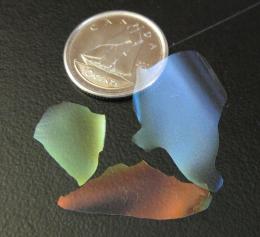Nov 18 2010
Using nanocrystals of cellulose, the main component of pulp and paper, chemistry researchers at the University of British Columbia have created glass films that have applications for energy conservation in building design because of their ability to reflect specific wavelengths of light, such as ultra violet, visible or infrared.
These nanoporous films, described in a paper published in today’s issue of Nature, may also be used in optical filters, sensors, or for molecule separation in the pharmaceutical industry.
 Red, green and blue films.
Red, green and blue films.
“This is the first time that the unique, helical structure of cellulose has been replicated in a mineral,” says Mark MacLachlan, associate professor in the chemistry department at UBC and co-authour of the paper. “The films have many applications and we created them from an exciting new product derived from our wood processing industry right here in British Columbia.”
At the molecular level, the films have the helical structure of nanocrystalline cellulose, a building block of wood pulp, explains MacLachlan.
MacLachlan and PhD student Kevin Shopsowitz, post-doctoral fellow Hao Qi and Wadood Hamad of FPInnovations, stumbled upon this discovery while trying to create a hydrogen storage material.
The UBC researchers mixed the cellulose from the wood pulp with a silica, or glass, precursor and then burned away the cellulose. The resulting glass films are composed of pores, or holes, arranged in a helical structure that resembles a spiral staircase. Each hole is less than 1/10,000th of the diameter of a human hair.
“When Kevin showed me the films and they were red, blue, yellow and green, I knew we’d been able to maintain the helical structure found in the cellulose.”
“The helical organization we produced synthetically mimics the structure of the exoskeletons of some iridescent beetles,” says Shopsowitz.
The pores in the helix give the films a wide range of applications. When certain liquids are added to the film, the liquid gets trapped in the pores and changes the optical properties of the films.
“By functionalizing the pores to make them more selective to particular chemicals, we may be able to develop new sensors that are very sensitive for detecting substances in the environment,” says Shopsowitz.
To reduce the energy needed to cool buildings, windows could be treated with the transparent films that reflect infrared light – the light that heats up a building. Right now, metal particles are often used to do this but they tint the windows brown.
This research was done in partnership with FPInnovations, an organization dedicated to developing new products from the forest sector, and with funding from the Natural Sciences and Engineering Research Council of Canada.